Does the claim that veganism can solve world hunger ignore the complexity of food insecurity? Why is hunger on the rise even though we have more than enough food? Find out where our food is going and get an honest answer to world hunger.
This article is part of an eCourse.
Take The eCourse NowCan Veganism Solve World Hunger?
Veganism alone cannot solve world hunger. However, world hunger cannot be solved without a global shift to plant-based diets. World hunger is a multi-faceted problem that requires a multi-faceted solution. Animal agriculture impacts each of these facets in some way.
We already have more than enough food to feed everyone, yet hunger continues to rise even as poverty declines. Read more below (or watch the video above) to learn where our food is going, the impact on our planet, and what we can do to solve world hunger.
The claim that veganism can solve world hunger provides an extremely persuasive argument for dietary change that bypasses more controversial issues like animal rights and lands squarely in the heart of our humanity.
As such, it’s a common declaration used within vegan activism. (I myself made this exact statement in the fourth video I ever made.)
As good as this claim looks for veganism, making such a sweeping proclamation does a disservice to the true complexity of world hunger. Let’s take an honest look at some of the primary drivers of food insecurity, and what it really takes to solve world hunger. tweet this
Do We Have Enough Food to Feed the World?
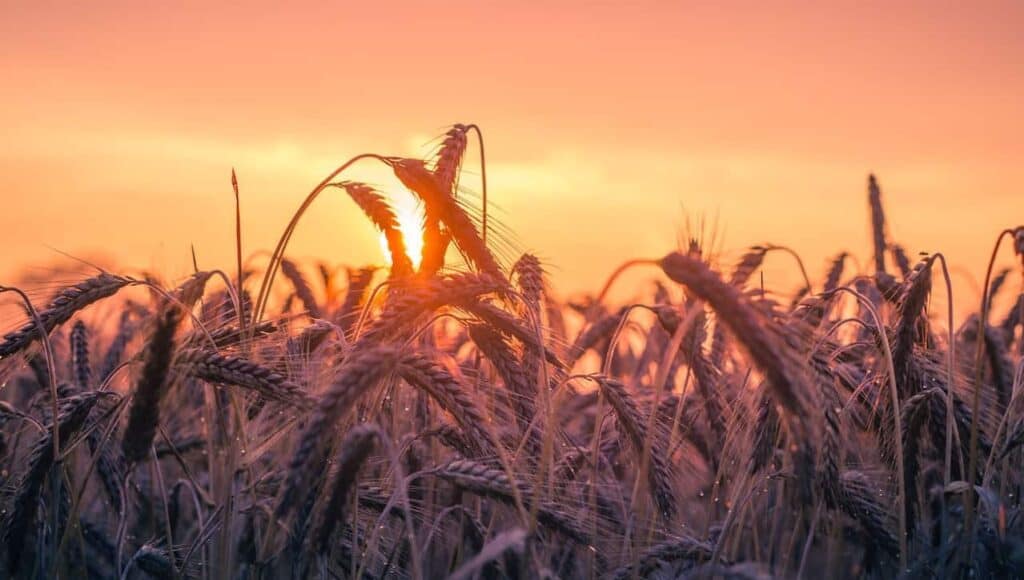
Before we dive into the question of whether veganism can solve world hunger, let’s address a common misconception. On its face, world hunger would seem to be a matter of food scarcity (not having enough food).
However, we already have more than enough food to feed the entire world’s population.
In theory, we currently produce enough food for between 10 and 14 billion people1—exceeding the current population of around 8 billion (as of this writing)2 and even eclipsing the United Nations‘ population projection of 9.7 billion by 2050.3
Our global agricultural production continually outpaces population growth. Yet the number of people going hungry continues to rise.4
Prompting the question: where is all the food going? tweet this
Why People Think Veganism Can Solve World Hunger
The paradox of food scarcity in the face of an overabundance of food comes down to—in large part—how that food is distributed.
The answer to “where is all the food going?” is one of the primary reasons people think veganism can solve world hunger.
Our Food Is Going to the Animals We Eat

Over a third of our crop calories are fed to the animals we eat.5 Less than half of the world’s cereals are eaten directly by humans.6
Overall, more than half of the plant protein we grow goes to the animals we raise for food instead of directly to humans.7
In fact, the United States alone could feed every person facing hunger in the world today8 with the grains we feed to farmed animals—with a surplus left over.9
Eating Animals Is Extremely Inefficient
Consuming animals is a profoundly inefficient means of gaining nutrition. For example, the World Resources Institute found that “beef” passes on only 1% of the calories and 4% of the protein from the feed used to produce it.10
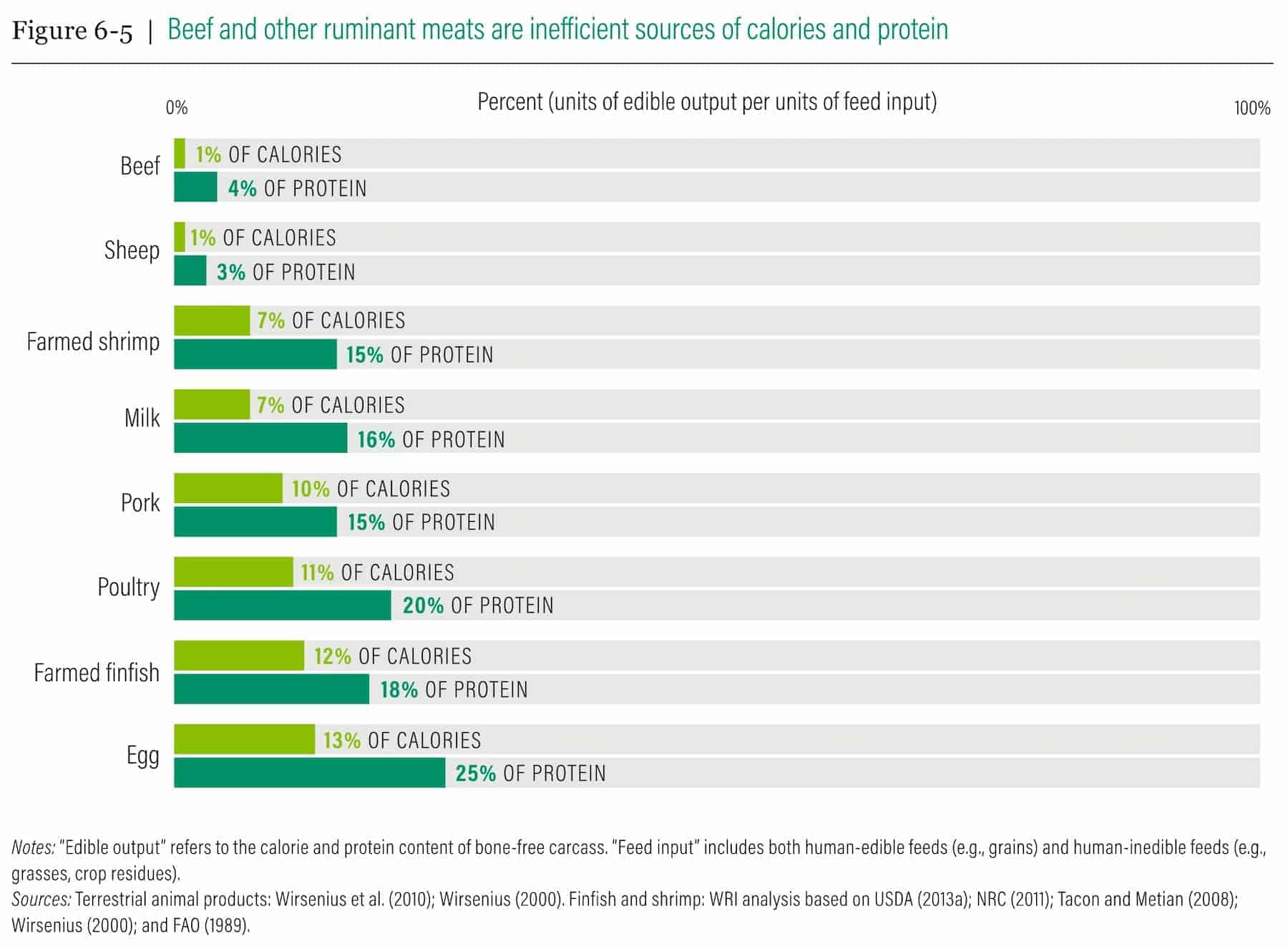
Even the most “efficient” animal product addressed in the report (eggs) passed along a meager 13% of calories and 25% of protein.
So if you’re wondering where vegans get protein, we simply remove the inefficient “middle animal” and get it directly from the plants.
Animal Agriculture Requires More Water, Energy, & Land Than Plant Crops
Our food crops are not the only resources diverted to the animals we raise for food. Compared to crops with equivalent nutritional content, animal products demand significantly more water, land, and energy.11
For example, the average per-calorie water footprint of beef is twenty times higher than that of cereals and starchy roots.12
Half of our planet’s habitable land is used for agriculture.13 Astoundingly, “more than three-quarters of this [land] is used for livestock production, despite meat and dairy making up a much smaller share of the world’s protein and calorie supply.”14
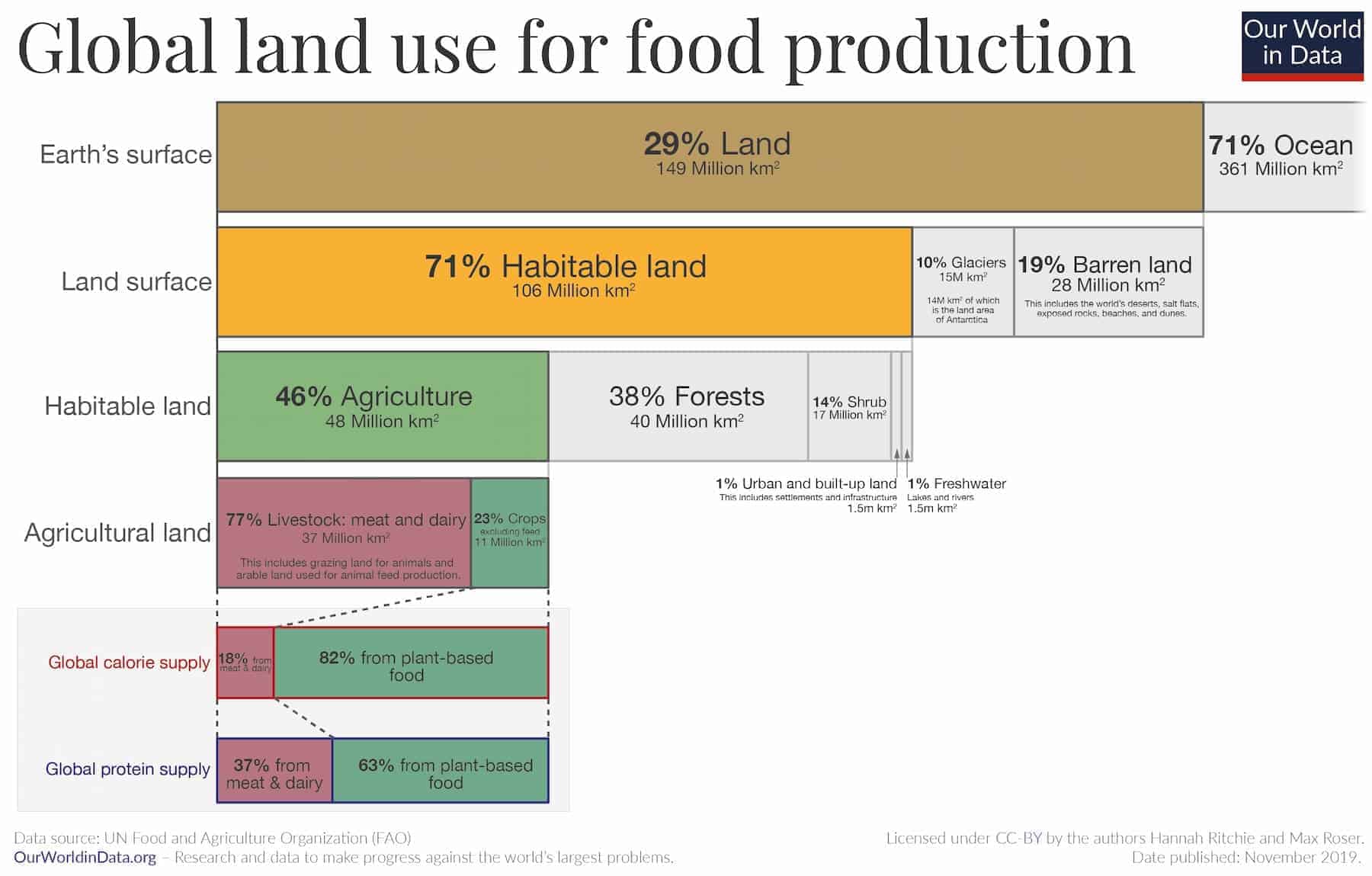
Plant-based diets require significantly less land. In fact, if everyone in the world went vegan, we could reduce land use for agriculture by 75%.15
An emerging field of harnessing microorganisms to grow our food could free up even more land, with one method using bacteria requiring 1,700 times less land than soybeans to produce the same amount of protein.16
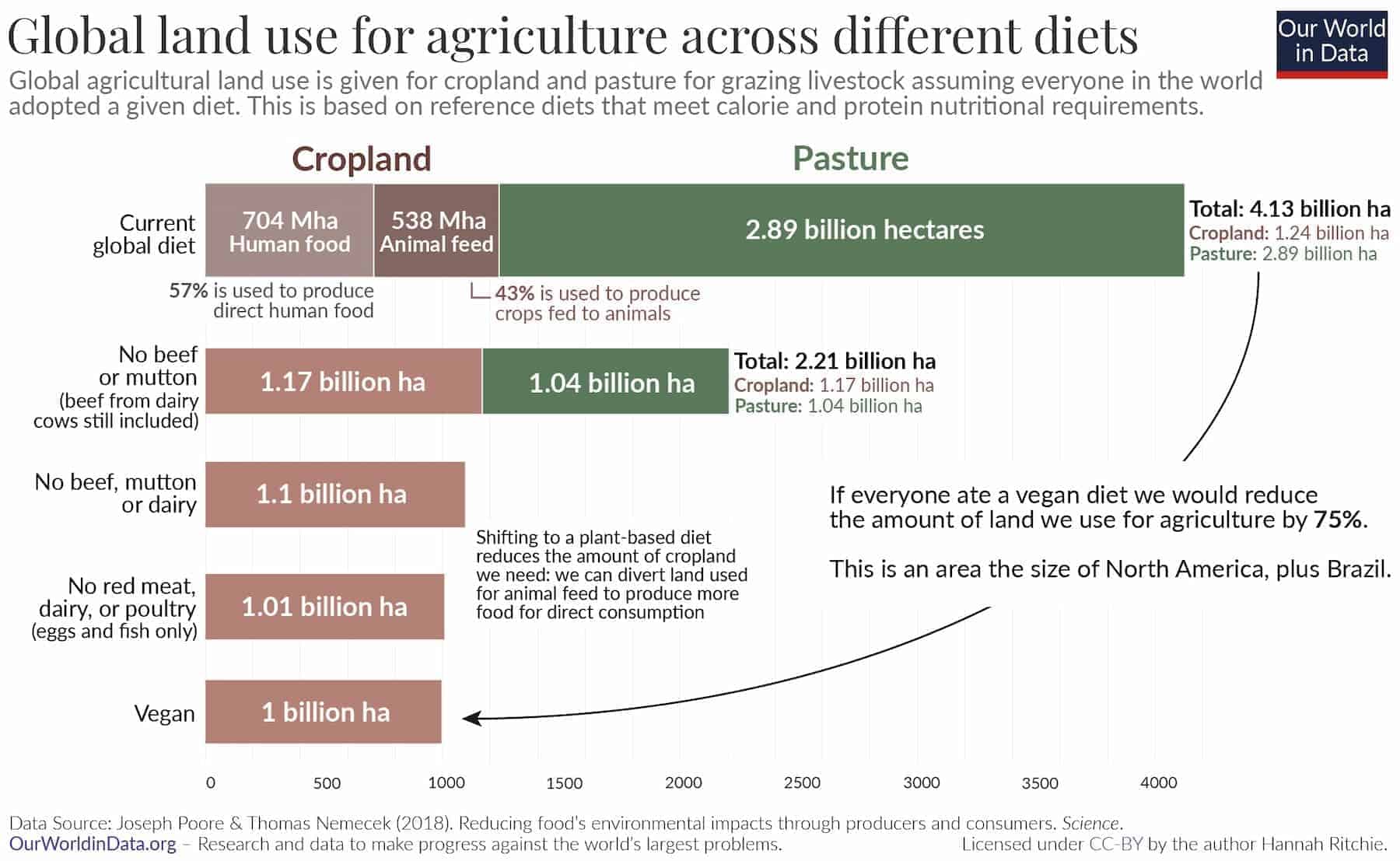
Unfortunately, we are going in the opposite direction with our demand for land. While the human population growth rate has actually slowed, the farmed animal population growth rate continues to rise17—and with that, a need for more land we do not have.
We’re facing an overpopulation crisis not of humans, but of the animals we raise for food. tweet this
Climate Change Is a Leading Cause of World Hunger
Animal agriculture is a leading cause of climate change, which in turn is one of the leading causes of increasing global hunger.
Animal agriculture is a leading cause of climate change,18 which in turn is one of the leading causes of increasing global hunger.19
In fact, in their report outlining the most effective means of mitigating climate change, the Intergovernmental Panel on Climate Change (IPCC) declared:
“The greatest Shift potential would come from switching to plant-based diets.”20
Please see my video and article “Everything Wrong With Environmentalism in 11 Minutes or Less” for more information on climate change and animal agriculture.
The intricacies of climate change’s effect on food insecurity are far beyond the scope of this video and article. Please see the linked sources for more information.21
In short, with our current food system and global dietary trends, we’re not only unable to feed the world’s hungry, but—more importantly—our planet simply cannot sustain the way we are eating.
Why Veganism Alone Cannot Solve World Hunger
The stark reality of our profoundly unsustainable food system certainly points to a dire need for a global shift to plant-based diets. Why then is veganism not the solution to world hunger?
- Inequitable distribution:
One key reason is inequitable distribution. It’s not only that we’re diverting resources to the animals we eat—it’s also that we’re diverting those calories away from the people who need them most to the animals who will be consumed by the people who can afford the animal products.22
As Richard Oppenlander writes, “82 percent of the world’s starving children live in countries where food is fed to animals, which are then killed and eaten by more well-off individuals…”23 Simply having more land and food doesn’t mean that land and food will suddenly be distributed in an equitable manner. - Animal agriculture isn’t the only cause of food diversion:
Additionally, animal agriculture isn’t the only cause of food diversion.- With the increasing demand for biofuel, we’re literally burning around 11% of the world’s cereals.24
- Further down the supply chain, food waste accounts for the loss of existing nutrition.25
- Another driver of food insecurity is political and institutional conflict, including resource and trade wars.26
- It’s not a simple matter of substitution:
It’s also important to note that the crops we feed to non-human animals aren’t always suitable for human consumption, so it’s not as simple as shifting them directly to people. In the same vein, land used for grazing farmed animals isn’t always suitable for growing crops.27 - Food insecurity occurs at many levels:
Lastly, food insecurity is not just an issue at a country-by-country level: it includes factors like the unavailability of food due to food deserts and even the “unequal distribution of food between household members.”28
How Do We Solve World Hunger?
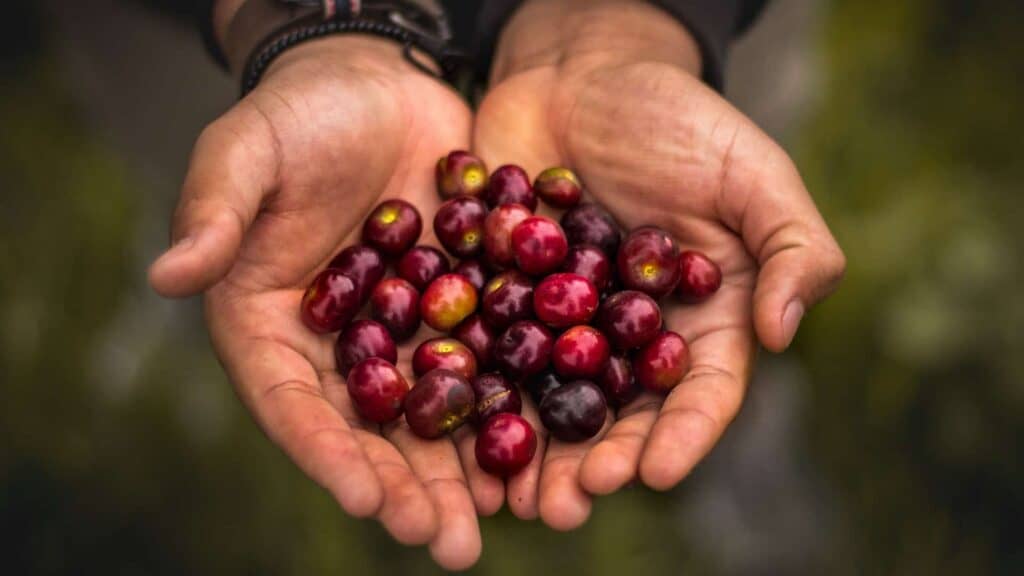
If we were to take the issues of scarcity and distribution in isolation, the main “solutions” would seem to be that we:
- need more food and
- need more wealth for those unable to afford access to food.
However, as we’ve learned, we already have more than enough food. And in regard to increasing wealth, the United Nations Environment Program (UNEP) points out that:
“While poverty has decreased considerably–from 36 per cent in 1990 to 10 per cent in 2015–efforts to reduce hunger have been comparatively less successful.
In fact, after decades of modest but steady decline, hunger began to rise again in 2015…Many countries now face a “double burden” that includes both undernutrition and overweight or obesity.”29
— the United Nations Environment Program (UNEP) on hunger increasing as poverty decreases
A reason for this seemingly paradoxical phenomenon is explained by Bennett’s Law—a well-established fact that as people’s income rises, so does their consumption of nutrient-dense foods like animal products.30
While animal product consumption in some countries has slowed or even slightly decreased, the majority of the world population’s consumption is increasing with improving living standards.31
Why Veganism Is Necessary to Solve World Hunger
While veganism alone cannot solve world hunger, world hunger cannot be solved without a global shift to plant-based diets.
tweet this— Emily Moran Barwick
World hunger is a multi-faceted problem that requires a multi-faceted solution.
As we’ve learned, the consequences of animal agriculture impact each of these facets in some way.
While veganism alone cannot solve world hunger, world hunger cannot be solved without a global shift to plant-based diets.
Such a shift would increase the food supply, free up land, water, and other resources, help lower food prices, increase access, and allow for movement towards sustainable farming and more equitable food distribution.32
If you think about it, the ripple effect of increased land, water, and other resources would theoretically reduce the prohibitive cost of and access to farmland—and even the need for conflict over limited resources. It would also reduce the mounting pressures of the climate crisis—which is arguably the most pressing issue of our time.
In Closing…
To learn more about this complex topic, I highly recommend checking out the nonprofit A Well-Fed World, which “highlights the ways in which shifts towards plant-based foods increase the available food supply — and how this shift improves distribution, access, equity, and sustainability.”33
Don’t forget to take the free eCourse to test your knowledge about veganism and world hunger!
Please share this article to help inform others.
You can also download this world hunger infographic to share on social media.
Be sure to link to this article & tag Bite Size Vegan!
To stay in the loop about new Bite Size Vegan content and updates, please sign up for the newsletter or follow the Telegram channel for the most reliable notifications.
To support educational content like this, please consider making a donation. Now go live vegan, and I’ll see you soon.
— Emily Moran Barwick
Help End Hunger by Going Vegan!



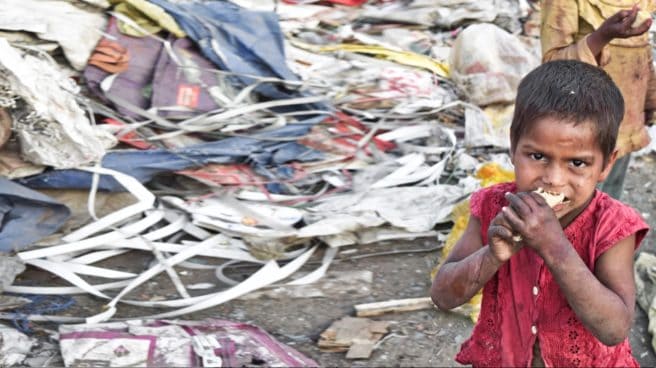


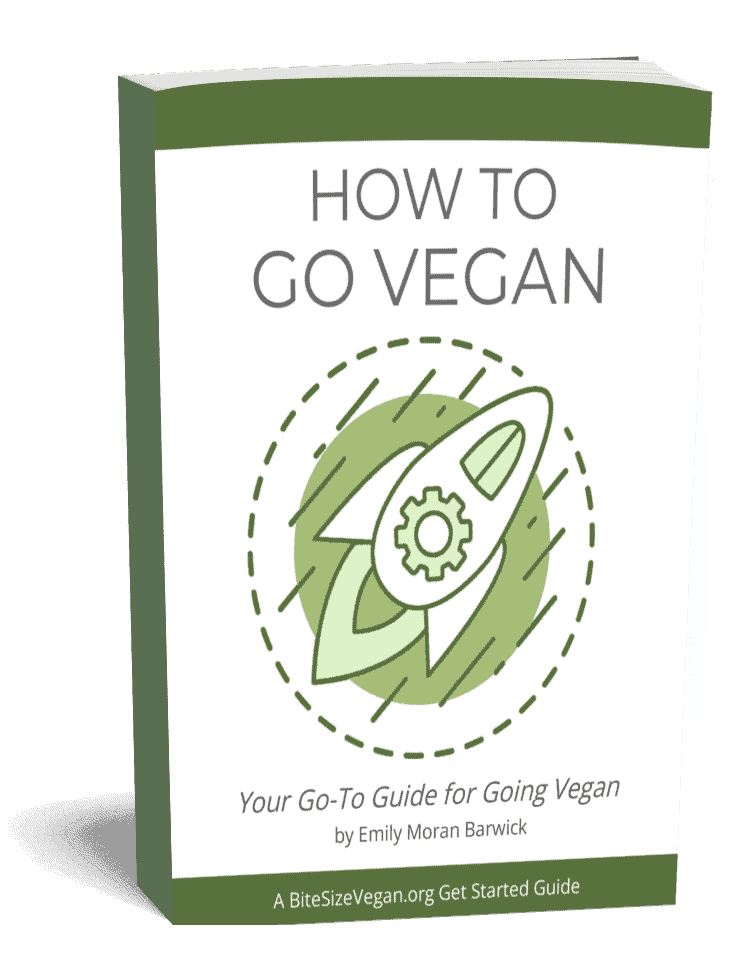
Emily, as always I’m blown away by how you take such a MASSIVELY COMPLEX topic and lay it out for us with such care, clarity, and balance. And those animations in the video! They really do make it so much easier to follow all of the information you’ve packed in so effectively. I also appreciate you poking fun at yourself and your early video :) Thank you for continuing to take on the burden of research, writing, editing, and distilling down these vital topics for us out here to be able to just watch/read, learn, and have another amazing teaching tool to educate others! You are so valued.
Anesh, Thank you so very much for your kind words about my work. It’s so rewarding to hear that the time and effort I put in come through effectively. This topic is indeed extremely complex. It’s very challenging to take on something like “world hunger” and try to create an overview without being overly reductive. I hope that this video and article hit a good balance. Thank you again, as always, for taking the time to share your feedback!
Thank you so much for this incredible synopsis Emily! I watched it a few times – so much to consider. I appreciate so much how you untangled the web- so much to unpack and ponder. Thanks for the update. Great job!
Cathy, thank you so very much. I’m really thrilled to hear this. I so appreciate you taking the time to give your feedback. This was such a challenging topic to attempt to take on and distill without over-diluting/over-simplifying. It’s extremely rewarding to hear your feedback. Thank you so much!
Wow. That was really well thought out and presented.
Thank you so much, Brian! Really appreciate the feedback and so glad to hear this.
Wonderful and informative as usual, Emily. I was not familiar with inequitable distribution. I did terrible on the quiz, but it is alright because I am learning which is the purpose of a quiz. I did like that my wrong answers were explained at the end of the quiz so I could see where I went wrong and what I have to learn more about.
Thank you, Sally. Yes, the intricacies of inequitable distribution and so many other factors of world hunger are incredibly complex! It was very challenging to cover this topic at a “high level” without overly reducing it. Glad you took the quiz! I do sometimes wonder if I make them too hard…I want to make them challenging enough to be intellectually stimulating, but not sure if I make them a bit much! But luckily, you can take them multiple times. And I do try to put explainers at the end. I’m glad that you found that bit helpful! As always, I appreciate your taking the time to comment!
Emily, the waste of food in my hometown ( the north east ) is very severe. I once worked at a Holiday Village for a month.I was shocked by the extent of people’s waste. That was the first time I realized that people in Northeast China waste food so much. The dishes filled with roast whole sheep, stewed live fish, and various farm dishes were thrown into the garbage can without a few bites, and some people even left the whole table. There’re so many vanity people take wasting of food, wearing fur and leather as proud! Which I hate so much and it’s very very easy to get impacted as a sensitive child by the vanity people around you and you always want to be someone but never yourself. And the vanity is being more servere now. It’s also why I feel so lucky to make the connection, you and Gary are so pure and simple and you’re always planting the best value seeds, and it will always get the best value fruits.
Chris, that would be very difficult to see—not only the consumption and usage of sentient beings, but also the overt waste in the end! I too am glad that you made the connection. While your sensitivity as a child may have made things more challenging (I know it did for me!), it no doubt helped you connect with non-human animals. Sending you much love.
Please as always, feel free to ignore me since I value your time and don’t want to waste ANY of it or making any interruptions. sometimes I just rambling a bit.
Wow the amount of research and presentation artistry you do is impressive.
Just wanted you give you a tooltip: Have you looked into Logseq or other tools for thought? If not, I believe you can reduce a lot of your effort and time and at the same time even increase your output. Logseq is free, open source and local.
I find it insanely usefull myself and makes my brain actually want to work and research complex topics.
Kenneth, thank you so much for your kind words about my work! I’ve not looked into Logseq specifically (though I have now at least a little in seeing your comment). But I have delved into similar tools. It does look profoundly powerful. Sometimes for me, though, I get lost in the infinite capabilities of such tools, and learning all the options and trying to determine the best way to use them becomes its own full-time occupation! I think I’ve spent collective months trying out various systems. I’m not saying I won’t look further into it. I always just have to be cautious with myself and such infinitely-configurable tools! I do appreciate the recommendation. And it’s encouraging to see it has a Zotero integration, which is the citation software I use.
I fully agree it quickly becomes an infinite rabbit hole. I just keep it very very simple. I recommend Sönke Ahrens book “How to take smart notes”.
Thank you for the suggestions :)
I have been vegan for around forty years.
And I am learning with you.
A graceful mind you have.
Merci.
luc
Thank you so much, Luc. I’m honored. Also, so heartening to have longterm vegans like yourself as living testaments! Thank you for taking the time to comment!
I can’t imagine how hard it is to research all of this information. But imagine the brilliance of being able to convey it in such a way that people (like me) can actually understand and appreciate.
I am so thankful that Bite Size Vegan has taken on this task. It is very helpful to me, and I’m sure to others who are faced with family members who want to know why they are choosing to be vegan. These videos help me to give them something more to think about. Thank you Emily!
Thank you so much, Mary Carroll! This comment means more to me than I can possibly tell you. It is quite an undertaking to research and then attempt to “distill” immensely complex topics into something accessible without overly simplifying them to the point of inaccuracy. I am honored that you find my work to be a helpful resource. It’s why I do this, despite the many challenges! Thank you so much for taking the time to share this with me. It means the world!
Hi Emily and all participants, vegan or otherwise
Could it be that any large-scale hunger in the world today is generated more by politics, economics and the power of big corporations, than by what the greater populace eats or avoids eating? If veganism were the dominant way of living, would there not still be the blinkered, profit-driven mindset, just with a change of focus? The big corporations would simply adjust to veganising all the non-vegan consumer goods – fast foods, automotive, medical, cosmetics, household, everything – and the profit-hungry practices, exploitation, eco-destruction and corruption would continue uninterrupted.
Galina
Galina, thank you for the thoughtful reply. As I mentioned in this article and video, that’s precisely why veganism ALONE is not THE answer—a vegan world will not automatically solve the issues you mentioned. However, without a shift to plant-based diets, there is NO WAY to address world hunger effectively.
Thank you for your response, Emily, and for keeping us always on our toes, thinking and questioning ourselves, others and the reality of the world in which we live.
You are so very welcome, Galina. I’m a huge advocate of continual self-evaluation and life-long learning. I speak to that a great deal in my Wake Up Call for Vegans speech. I’m always finding ways that I am still so unaware!
I’m afraid we would need a completely different sort of system to fix these other systemic issues. One where the best interest of the many outweighs the interest of the few. But if you believe the propaganda, any alternative is the most evil of evils and has never worked. That is why we have had to bomb and coup all these socialist states for the last 100 years. There simply is no alternative to our current capitalist system.
I want you ( Emily ) to run for office . I think your youth, knowledge, passion, and determination to make a change for the world makes you the number one pic…… please run for office…… pretty please
I think putting people like you to combat the greed, power hungry, self interested people will put an end to the ruthlessness, savagery, greedy, power hungry humans out of business……… you can make a change Emily
Aldo, thank you for the endorsement :) I’m not sure how suited I am for the political arena… I do greatly appreciate your encouragement and kind words. I do very much hope to make a difference in this world!